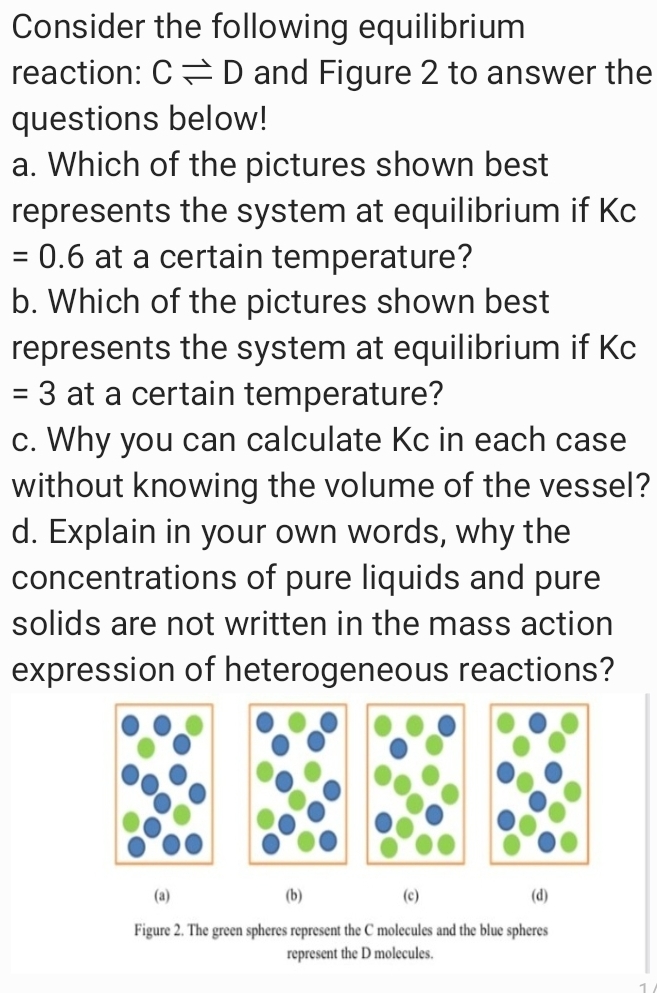Consider the following equilibrium reaction: C= D and Figure 2 to answer the questions below! a. Which of the pictures shown best represents the system at equilibrium if Kc = 0.6 at a certain temperature? b. Which of the pictures shown best represents the system at equilibrium if Kc = 3 at a certain temperature? %3D
Consider the following equilibrium reaction: C= D and Figure 2 to answer the questions below! a. Which of the pictures shown best represents the system at equilibrium if Kc = 0.6 at a certain temperature? b. Which of the pictures shown best represents the system at equilibrium if Kc = 3 at a certain temperature? %3D
Chemistry: The Molecular Science
5th Edition
ISBN:9781285199047
Author:John W. Moore, Conrad L. Stanitski
Publisher:John W. Moore, Conrad L. Stanitski
Chapter12: Chemical Equilibrium
Section: Chapter Questions
Problem 61QRT
Related questions
Question

Transcribed Image Text:Consider the following equilibrium
reaction: C= D and Figure 2 to answer the
questions below!
a. Which of the pictures shown best
represents the system at equilibrium if Kc
= 0.6 at a certain temperature?
b. Which of the pictures shown best
represents the system at equilibrium if Kc
= 3 at a certain temperature?
c. Why you can calculate Kc in each case
without knowing the volume of the vessel?
d. Explain in your own words, why the
concentrations of pure liquids and pure
solids are not written in the mass action
expression of heterogeneous reactions?
(a)
(b)
(c)
(d)
Figure 2. The green spheres represent the C molecules and the blue spheres
represent the D molecules.
Expert Solution
This question has been solved!
Explore an expertly crafted, step-by-step solution for a thorough understanding of key concepts.
Step by step
Solved in 2 steps with 2 images

Knowledge Booster
Learn more about
Need a deep-dive on the concept behind this application? Look no further. Learn more about this topic, chemistry and related others by exploring similar questions and additional content below.Recommended textbooks for you

Chemistry: The Molecular Science
Chemistry
ISBN:
9781285199047
Author:
John W. Moore, Conrad L. Stanitski
Publisher:
Cengage Learning


Chemistry: An Atoms First Approach
Chemistry
ISBN:
9781305079243
Author:
Steven S. Zumdahl, Susan A. Zumdahl
Publisher:
Cengage Learning

Chemistry: The Molecular Science
Chemistry
ISBN:
9781285199047
Author:
John W. Moore, Conrad L. Stanitski
Publisher:
Cengage Learning


Chemistry: An Atoms First Approach
Chemistry
ISBN:
9781305079243
Author:
Steven S. Zumdahl, Susan A. Zumdahl
Publisher:
Cengage Learning

Chemistry
Chemistry
ISBN:
9781305957404
Author:
Steven S. Zumdahl, Susan A. Zumdahl, Donald J. DeCoste
Publisher:
Cengage Learning

Chemistry for Engineering Students
Chemistry
ISBN:
9781337398909
Author:
Lawrence S. Brown, Tom Holme
Publisher:
Cengage Learning

Chemistry for Engineering Students
Chemistry
ISBN:
9781285199023
Author:
Lawrence S. Brown, Tom Holme
Publisher:
Cengage Learning